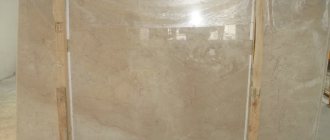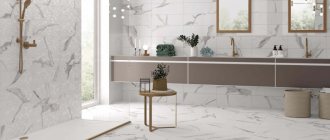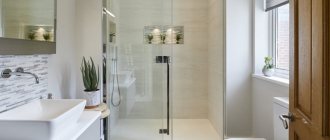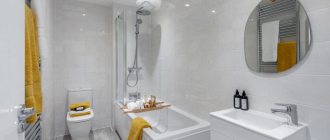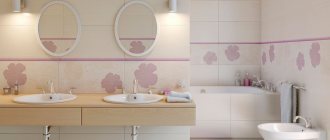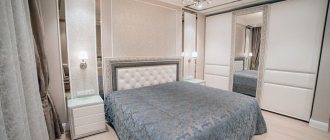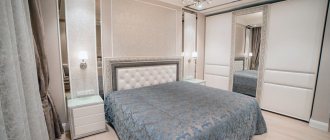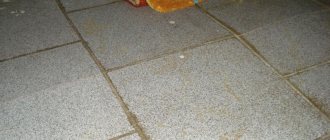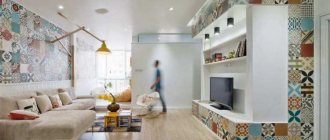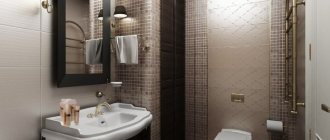Click to share
more
Marble is an extremely beautiful stone that gives the interior a noble and, what can I say, luxurious character. Although it is usually identified with classic bathrooms, it can be a great addition to a small modern apartment bathroom.
Marble is also used as a decorative element or to cover large surfaces - it always evokes admiration, and at the same time is very durable. Properly soaked, it can decorate your bathroom for years to come.
Marble for the bathroom - important to know
Marble is mainly composed of calcite or dolomite, and various minerals are used as additives. They are responsible for what impresses us so much: the different patterns and colors of individual types of marble.
Its texture may be directional, random, or slate-like . Fans of marble claim that you can see all the colors of the rainbow in them - they shimmer depending on the incidence of light and combinations with other materials.
What colors can marble take?
- White,
- Grey,
- Beige,
- Brown,
- Yellow,
- Green,
- Red,
- Black.
Choice depending on bathroom parameters
When selecting a material, it is important to take into account the size, style, and performance characteristics of the bathroom. In large rooms you can use different colors, textures, and types of installation. Compositions of marbled blocks in black, chocolate, and emerald shades are possible.
For compact rooms, it is necessary to select colors and textures that visually enlarge the space. It is optimal to decorate the upper part of the room with light-colored slabs; the design of the lower half should match the tone of the floor covering.
When selecting material, it is necessary to determine the method of laying the blocks. The diagonal method requires a larger volume of raw materials than when implementing standard checkerboard masonry.
What color?
The color scheme of natural and artificial blocks for the bathroom should be neutral and comfortable to use.
Light colors will visually expand the room. For compact bathrooms, marble slabs in white, beige, light pink, gray, and soft blue shades are optimal.
Medium-sized rooms can be decorated with marble in mustard, terracotta, and pink shades.
A neutral interior can be created using marble blocks of white, creamy, baked milk, and ivory colors. Accents in the room are made using slabs of golden, red, and turquoise shades.
In a room with good lighting and additional lighting, blue, gray, dark green shades of marble slabs are used.
Using black blocks you can create a stylish interior, but you must take into account the need for additional care and protection of surfaces from scratches. It is not recommended to use dark materials in small spaces.
An impressive design will be achieved by using marble blocks in the same color scheme and with a similar texture. The room will gain volume, surface joints will be smoothed out. It is optimal to combine 3-5 shades in finishing.
What texture and what size?
Marble blocks are produced depending on the processing with different surface textures:
- glossy;
- matte;
- textured.
Glossy surfaces are aesthetically pleasing and add additional volume to the room when creating a lighting system. The material is easy to clean, durable, and effectively reflects light. However, glossy slabs in rich shades can create strong glare.
Matte marble slabs are optimal for eco-style interiors and minimalism. The surfaces are distinguished by muted shades, allowing you to create a comfortable atmosphere. The material is suitable for flooring, because... more secure and wear-resistant.
Textured boards with an artificial composition allow you to reproduce the texture of solid wood, pebbles, and metal surfaces. The blocks are optimal for spacious bathrooms with an additional lighting system. In the Provence style, blocks with aged surfaces and patination are used.
The range of marble tile sizes is represented by standard and non-standard dimensions. For compact rooms, medium-sized blocks are optimal. Large slabs are used in spacious rooms. Common block dimensions are 300x600x20, 305x305x10, 600x600x20 mm.
White marble bathroom
White, spacious, minimalistic, hygienically clean - this is what the ideal bathroom looks like for many of us. White marble in such a room will make it additionally luxurious and unusually original. How to use this noble material to emphasize its uniqueness?
Let's find out how you can fantastically decorate a white marble bathroom:
- White marble, no matter what color the veins are, will look beautiful in the company of minimalist geometric furniture .
- A black painted niche , door or light fixture will add elegance to a white marble bathroom.
- White marble with brown veining will pair beautifully with a wooden floor , a wooden mirror frame or a wooden stool.
- A white marble bathroom is a great option for a modern design.
Distinctive features of marble finishing
Not every owner of a house or apartment can decorate a bathroom with marble. Marble is considered an expensive material, so only lovers of luxury can afford to decorate it.
The most valuable material is the one with small veins. The color scheme has a wide range of shades, including coal black, emerald, red-brown, steel gray, light pink tones.
Marble in XXL format
Another interesting offer that is now very popular is wide-format tiles , often with a marble finish. Large tiles, which are especially suitable for large spaces such as the bathroom, open up completely new possibilities.
Due to its large size, the entire pattern is presented on one plate (without unnecessary joints). It looks extremely phenomenal, especially in the shower area.
Main advantages
Advantages of marble bathroom tiles:
- aesthetics;
- long service life;
- high strength;
- resistance to temperature changes;
- moisture resistance.
A wide palette of shades and textures allows the material to be used in interior decoration in different directions, to create artistic panels, geometric patterns, and collages.
We also recommend watching - White tiles in the bathroom: features of use and combinations with other tones
Marble bathroom - marble elements
Floor-to-ceiling marble bathrooms make a big statement, but sometimes just one element of this stone is enough to make the whole room tasteful and original. This is how marble works. A bathroom with a marble shelf or decorative rosette will create a unique atmosphere!
What bathroom elements will look attractive in marble?
- Table tops,
- Shower walls,
- Mirror frames,
- Shelves,
- Window sills,
- Paintings,
- Cabinets,
- Door,
- Washbasins.
Design Features
Marble tiles will suit any type of interior; the main thing here is to combine all the elements wisely. It’s especially easy to overload the interior with elements in a small bathroom.
Important! The marble pattern on the tile is already a decorative element in itself, so it is not worth adding borders or mosaics to it. Such elements are suitable only for a large bathroom in a private house, where the area of this room will be more than 15 square meters. meters.
It is most difficult to use marble tiles in high-tech, loft or Japanese styles. For these styles, it is better to choose some elements made of marble: decorate only the floor or countertop with marbled porcelain tiles.
Marble tiles are best suited for the following styles:
- Classical. Here you can use any colors and their combinations.
- Arab. This style will turn the bathroom into a real hammam. For this style, you can take curtains with cucumbers or decorate one wall with a keeled arch.
- Modern. This style involves a minimum of details, so marble will be the main decorative element here. Bright colors are best here: blue, green or black.
Marble tiles will make the bathroom beautiful and noble in any color and style. It’s almost impossible to go wrong with the design here.
Marble sink
marble sink - regardless of color and shape - will always be an exquisite decoration of the entire room. It can have a completely minimalist shape and be beautiful in its simplicity.
However, if you are looking for something unique, something that attracts attention, it would be good to try a washbasin model whose function will be taken over by the background, because it will first of all represent a fantastic decoration.
What original marble sinks can be found in stores?
- Washbasins in shades of white, grey, blue and green,
- Washbasins inspired by nature - in the shape of a shell or a drop,
- Bowl-shaped marble washbasins
- Cylindrical and pedestal sinks,
- A washbasin whose design remains raw and unpolished.
Marble bathroom - what to look for?
Marble is a completely natural material, created through a long process, the traces of which can be seen in the form of interesting structures and textures.
Under the influence of high temperatures, wind, sun and water, it acquires enormous strength and hardness , as well as enormous weight. This fact cannot be ignored when decorating a bathroom. When planning the use of stone finishing, it is necessary to take into account the loads on the walls and ceiling.
Even if the weight of marble turns out to be too heavy, you don't have to give it up!
- In such a situation, it is worth choosing smaller interior elements made of marble (which have already been mentioned).
- A good solution is also modern tiles , the outer shell of which is made of natural stone 3 millimeters thick. Underneath there is a core up to 9 millimeters thick, made of aluminum, plexiglass or porcelain stoneware. These tiles are up to four times lighter than their marble counterparts!
Types of tiles for bathroom design
When selecting coating variations, they take into account the nuances and rely on the following recommendations:
- An expensive option is natural marble. It is luxurious, durable and ideal for wet areas. But in Russia, it is mainly imported, which means it is not mined. They can only cut it into slabs and put it into sale.
- Porcelain tiles. A good replacement for natural material, large-format sheets. The floor and wall will look like one as a result of a minimum number of joints.
- Marble tiles are a good option for saving money. But the dimensions of the tile differ from the natural product by more than 10 times.
Large tiles are sold in sizes 20x80 or 40x40 cm.
Marble bathroom in fantastic combinations
Marble walls and floors in the bathroom look very impressive. We can say that this is not only a decoration for the bathroom, but also (or perhaps we should say: first of all) a unique decoration. So what accessories or materials can be used here so as not to spoil the entire interior, but, on the contrary, to emphasize its uniqueness? What does marble go with?
Here are some pairing tips:
- White, gray or beige marble combined with black,
- Walls of white marble with black veining are combined with a floor in a black and white, geometric pattern,
- Marble walls against a wooden floor,
- The floor matches the color of the veins on the marble walls,
- Marble walls and floors form the backdrop for simple shaped accessories in gold,
- Marble elements in combination with red brick on the wall (here it is worth paying attention to the fact that brick and marble are not directly adjacent to each other - each of the materials is a characteristic decoration, so it is better to separate them with other elements of the arrangement or place them at some distance from each other friend).
How does it look in the interior?
If the idea of using stone in your bathroom sounds tempting, choose one of the following styles:
- Classic. For finishing, choose a beige or white shade of marble and use it simultaneously on the floor and walls.
- Empire style And other luxurious styles, like Baroque. Light marble texture is combined with dark shades, gold or bronze, and antique lamps.
- Modern. If in the first two interiors it is permissible to complement the already luxurious stone with rich decor (for example, milling on the tabletop), then this should not be done here. The bright texture itself stands out in the bathroom. Color - white, gray, black.
- Minimalism. Choose a neutral texture with non-contrasting veining. You can decorate all surfaces except the ceiling.
- Scandinavian. Here the details are made of marble: the sink, the shower tray, the accent wall.
Perhaps nothing has yet been invented more versatile and beautiful than marble for finishing. The secret of proper use is the right shade, suitable texture, dosage.
Protecting marble from moisture
Companies protect marble from water absorption already at the stone processing stage. However, it is also worth impregnating it at home with specialized products. Thanks to this, you will be sure that this expensive and beautiful stone will not be damaged during use of the bathroom. After all, it is constantly exposed to water and water vapor.
What do you need to know about impregnating marble?
- Impregnation protects all micropores from moisture penetration.
- Impregnation of marble is carried out at the very beginning of use and is repeated from time to time.
- Impregnation makes the marble more saturated.
- In areas particularly susceptible to water penetration, it is recommended to use a 2 millimeter thick waterproofing membrane.
Marble tiles, that is, imitating stone
Real marble is often an expensive solution.
The beautiful pattern of natural stone with spectacular multi-colored veins has delighted both artists and interior designers since ancient times. Italy is in the lead, where marble deposits are quite rich. The most popular marble is Carrara marble, which is mined near the city of Carrara: white with gray “shadows”. But the colors of marble can be different - the color palette varies from white and cream, through pink, orange, green, to brown and black.
All this wealth is used by manufacturers of ceramic tiles with designs that perfectly imitate marble. What is important is that this solution is much cheaper than real marble. In addition, you save natural resources, which are not unlimited.
Photo examples of kitchen and dining room design
view album in new window
In the photo: Kitchen set with a mirrored apron and island
A countertop for a kitchen or kitchen island can be made of different materials: agglomerate and corian (which we discussed above), artificial stone, chipboard and MDF, as well as natural marble. There are countertops made of granite and quartzite, and in the most luxurious projects - from onyx, agate, and labradorite. From floor designs to countertops and backsplashes, white is the most popular color in kitchen design. In the kitchen, the marble pattern can also be found in the design of utensils (on cutting boards, tableware and serving utensils, cups, trays).
Stunning fashionable kitchen with emerald splashback and white cabinetry
view album in new window
In the photo: Kitchen with a green kitchen apron and a light countertop
A stunning design move from an accent kitchen apron in an emerald shade in the form of a diagonal design with boar tiles (herringbone pattern, like French parquet).
Luxurious classic kitchen with designer finishes in warm colors
view album in new window
In the photo: Luxurious kitchen with a chocolate apron and countertop
Classic kitchen renovation with large U-shaped cabinetry and pantry cabinets. On the facades there are relief carved wooden parts in gold and gold handles.
Art Deco dining area in a luxury apartment
view album in new window
In the photo: Beautiful dining room decorated with white and black marble (porcelain tiles) and gold accents
A dining area with a claim to a cinematic level of interior. Art Deco style always looks amazing in an open plan.
Dining room in gray tones with black cupboards and dining area
view album in new window
In the photo: Art Deco dining room in black and gray colors
A wonderful example of understated Art Deco chic for the interior design of a formal dining room for 8 people. On the left is the kitchen with a bar counter, on the right is the living room.
Dining area in a small kitchen in ash-stone tones
view album in new window
In the photo: Dining area in the kitchen in a modern style
And in a small kitchen there is a place for unusual decoration and original design solutions! For example, a panel of lamps in the parametric style.
Massive kitchen with varnished wooden fronts
view album in new window
In the photo: Luxurious kitchen with a large set up to the ceiling
Luxurious kitchen interior with built-in furniture and lacquered facades. The finishing of the floor, countertops and apron imitates natural stone of different types.
Marble tiles as a finishing material
Marble tiles, that is, with a marble pattern, are a great idea for an elegant finishing material. It has all the advantages of ceramic tiles: it is durable, resistant to damage, abrasion and moisture. So it can be safely placed both on the floor and on the walls.
Marble tiles are often used on all bathroom walls and floors. Large-format tiles and rectified (seamless) tiles are very popular, allowing to achieve the effect of homogeneous surfaces. Together with the shiny, almost mirror-like surface, it creates a dazzling impression in the interior. But keeping it spotlessly clean can be challenging.
Each store has a very wide range of marble tiles. Prices are both low and surprisingly high. This is because marble has a different quality and parameters. The price most often depends on its type, production and place of origin.
Pros and cons of marble
The aesthetic advantages of marble are undeniable. But the bathroom is a specific room with difficult conditions; it must be kept absolutely clean. This is important not only for beauty, but also for compliance with sanitary rules. Before you start creating a marble interior, you should familiarize yourself not only with the advantages, but also with the disadvantages of the material. Marble is expensive, so you should be careful when purchasing it.
Tiles and marble countertops in the bathroom have several important advantages. Material:
- is natural, environmentally friendly, has a positive effect on the microclimate;
- has high strength, resistance to moisture, temperature changes, retains quality for several decades;
- has a wide range of shades.
Marble countertops are highly durable
Marble contains pores that allow air circulation. Facing with such tiles will provide a healthy microclimate in the room. Moisture and elevated temperatures do not have a negative effect on the stone. In the color palette you can choose blue, brown, green, black tones. This allows you not only to accurately select the material for finishing, but also to create ornaments and panels using marble tiles for the bathroom.
The high price of marble can be considered a disadvantage. But the costs for it are paid off by a long service life and the incredible beauty of the interior. The material has other disadvantages that are worth paying attention to.
Spectacular marble panel in the bathroom interior
Despite its high strength, it can be damaged by mechanical stress. Chips and cracks may appear on marble bathroom countertops and tiles if heavy objects are dropped on them. The stone requires compliance with the rules of care. It needs to be protected and special sealants applied. Do not use household chemicals with active ingredients to remove stains. Contaminants should be removed with soap. If cosmetics or perfumes get in, they must be removed immediately, otherwise the substances will penetrate the pores and remain in the stone.
Cast marble bathtub
A durable and stylish bathtub is the centerpiece of any elegant bathroom or bathtub. For many people, the pinnacle of luxury in the bathroom style category is the marble bathtub , associated with palaces and other luxurious interiors. When choosing a bathtub made of this material, you can be sure of its proven strength - much greater than, for example, ceramics.
Cast marble is a timeless material that, unlike ceramic materials, allows for a wide variety of shapes. It allows the production of shapes that would be unimaginable using conventional ceramics. Thus, marble baths have perfectly clean edges and perfectly smooth space inside.
The final surface finish consists of a layer of colored resin (gelcoat) that protects the cast marble from scratches as well as commonly used cosmetics and hygiene products.
more
Artificial or natural
Natural material is durable, high quality, aesthetically pleasing, but has a high price. Manufacturers have developed technologies for producing artificial analogues of stone for finishing premises and architectural compositions.
Materials made from artificial raw materials are classified according to their manufacturing method:
- to flexible;
- for injection molding;
- to oselkovye.
Molding material refers to composite raw materials, which consists of polyester resins, fillers made of crushed quartz, marble and other stones. The composition is optimal for creating sinks, countertops, balusters, sculptural compositions, and window sills.
Oselkovy marble belongs to a subtype of plaster for interior decoration, supplied in the form of a gypsum composition (white or tinted). The material is a liquid raw material with an adhesive base and is poured into a matrix form or applied with a spatula to the wall surface.
Flexible marble is produced in the form of decorative panels. The basis of the raw material is a block of plastic polymer. The outside of the slab is covered with a layer (up to 3 mm) of crushed marble chips, coloring pigments, and epoxy resin.
